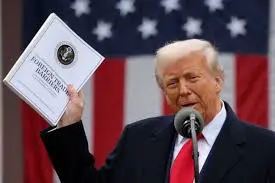US court curbs Trump’s tariff power: How it eases pressure on India

Trump’s Tariff Powers and the Legal Challenge
During his presidency, Donald Trump leveraged the IEEPA to impose broad tariffs on multiple countries. This move aimed to protect American industries by counteracting what the administration saw as unfair trade practices. However, critics argued that such sweeping tariff powers should be the domain of Congress, not a single executive figure.
The court’s ruling emphasized that the IEEPA does not grant the president unlimited authority to impose tariffs on imports globally. Rather, tariff setting is traditionally a legislative function. As a result, most of Trump’s tariff orders were struck down.
Immediate Implications for India
1. Relief for Indian Exporters
India’s export sector has been closely watching developments in the U.S. as it faced the threat of reciprocal tariffs. These U.S. tariffs were expected to mirror India’s own import duties on American goods, which could have triggered a costly trade dispute impacting approximately $129 billion worth of bilateral trade.
With the court’s ruling blocking these tariffs, Indian exporters—especially in pharmaceuticals, textiles, and engineering goods—can breathe a sigh of relief. This means fewer trade barriers and a more predictable market environment for Indian businesses relying on the U.S. as a key market.
2. Positive Market Reaction
The ruling immediately buoyed Indian financial markets. The Nifty 50 and BSE Sensex indices saw modest gains, fueled by optimism that the trade dispute would not escalate further. Information technology stocks, which generate substantial revenue from the U.S., saw a notable increase.
At the same time, the Indian rupee weakened slightly against the U.S. dollar amid a broader strengthening of the dollar post-ruling, reflecting typical currency market reactions to shifts in trade policy.
Strategic Opportunities for India
1. Diversification of Trade Partners
While the U.S. remains a crucial trade partner, this ruling encourages India to diversify its global trade relationships. Strengthening ties with the European Union, ASEAN countries, and the Middle East can reduce dependency on any one market and shield the economy from future trade shocks.
2. Strengthening Bilateral Negotiations
India is currently in talks to negotiate a Bilateral Trade Agreement (BTA) with the United States, aiming to boost trade to $500 billion by 2030. The court’s decision provides a favorable backdrop for these negotiations by reducing tariff-related tensions and opening space for more collaborative economic engagement.
Challenges and Uncertainties Ahead
Despite this victory for Indian exporters, the situation remains fluid:
- Possible Appeals: The U.S. government has signaled its intent to appeal the court’s ruling. This could prolong uncertainty, as tariffs may remain in place while the legal process unfolds.
- Ongoing Negotiations: The success of future trade agreements will hinge on political will on both sides, including how tariff and non-tariff barriers are addressed.
- Geopolitical Context: Global trade tensions, supply chain disruptions, and evolving policies under the current U.S. administration will continue to shape the landscape.
Conclusion
The U.S. Court of International Trade’s decision to limit presidential tariff powers marks a critical turning point in trade policy. For India, this translates into reduced immediate pressure from potential U.S. tariffs, offering relief to exporters and investors alike.
More importantly, the ruling encourages India to pursue a diversified trade strategy and engage more constructively in bilateral negotiations with the U.S. While challenges remain, India is poised to leverage this development to strengthen its economic position on the global stage.






